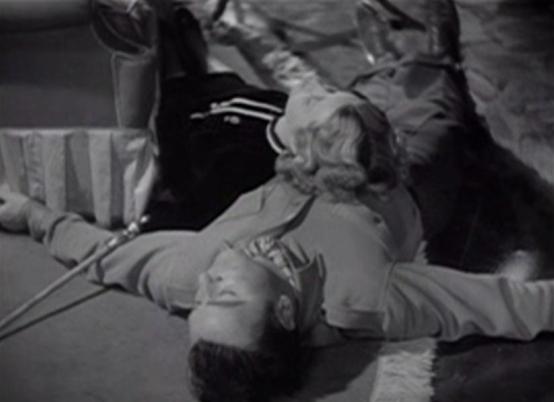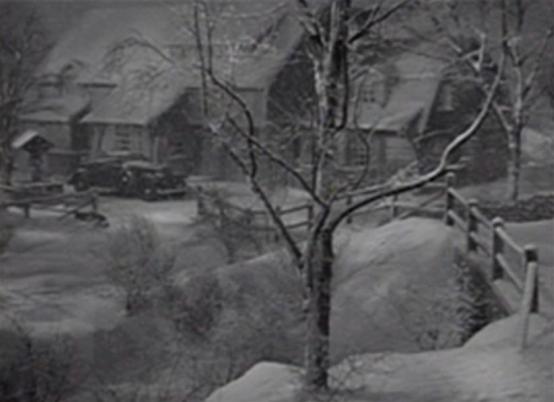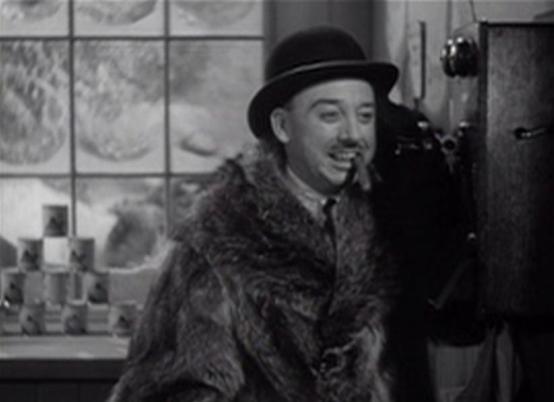I fell in love with Snowed Under when Turner Classic Movies played it during their Summer Under the Stars tribute to Glenda Farrell last August. As much as I enjoyed it then, I knew I’d want to return to Snowed Under again during the dead of winter so I could shiver along with six of my favorite 1930s Warner Bros. contract players in a similar setting. Twelve inches of snow this past Tuesday night set the perfect stage for me to return to George Brent’s Bridgeport, Connecticut cabin from my couch on equally blustery Long Island.
Brent plays Alan Tanner, playwright sensation struggling to come up with a decent third act for his latest, Roads End. With the premiere just a week away producer Arthur Layton (Porter Hall) convinces Tanner’s first wife, Alice (Genevieve Tobin), to visit her ex at his Bridgeport cabin and inspire him to complete Roads End. Tanner, meanwhile, is distracted from his work by youthful Bridgeport native Pat Quinn (Patricia Ellis), who’s home from college and convinced she is in love with the much older playwright. Shortly after Alice arrives another car pulls up with Orlando (Frank McHugh), the former milkman now employed as deputy sheriff and charged with collecting overdue alimony from Tanner for wife number two, actress Daisy Lowell (Glenda Farrell), who appears herself moments after her young attorney, McBride (John Eldredge), follows Orlando inside Tanner’s cabin.

Left to right, above: Glenda Farrell, Frank McHugh, Patricia Ellis (on couch), Genevieve Tobin (standing), George Brent and John Eldredge.
A blizzard rages throughout Snowed Under, dumping several feel of snow outside and confining our six stars–three men, three women–to the cabin. Young Pat wrecks Orlando’s car across the bridge that leads to the cabin just to make sure nobody can leave, specifically playwright Tanner, who Orlando is supposed to place under arrest.
The entire 63-minute movie is filled with witty dialogue that inspires dynamic performances from each of the six main characters with Tobin, Farrell and McHugh especially standing out. The three women, each linked past or present to the Brent character, pass snide remarks back and forth at one another, while each of the men inevitably wind up falling for one of the women, not without their fair share of male-female sniping along the way.
The connection between the Brent and Tobin characters is established right away with the original couple sharing a passionate kiss at the doorway of Tanner’s cabin upon Alice’s arrival. The playwright married his second wife, the actress (Farrell), on the rebound from his divorce from Alice, and that seems to have been a fiery relationship doomed from the start and ending in a second divorce for Tanner after only a year of marriage. Daisy has been collecting $300 a month ever since, though Tanner has fallen behind on his alimony payments causing Daisy’s presence at the cabin, which is also responsible for planting Orlando and attorney McBride on the scene. There’s just enough between Tanner and young Pat (Ellis) to leave you wondering whether or not they actually had a brief affair the previous Summer, though Tanner is no longer interested in the aggressive, yet sweet, young woman.
Snowed Under is filled with enough sophisticated dialogue to make you believe a hot shot young New York playwright, perhaps resembling the Brent character, would have been responsible for the original story, but that was not the case at all.
Snowed Under was based on a work of fiction under the same title that was serialized over seven issues of Liberty magazine between December 28, 1935 and February 8, 1936. Warner Bros. had actually secured rights to the story prior to its publication by Liberty, with first mention of casting coming as early as a mid-November 1935 issue of Film Daily. After replacing June Travis, who was busy on Ceiling Zero (1936), with Ellis, production began on November 22, the same date as another Warner’s title previously covered here, The Walking Dead (1936). Snowed Under would open in New York the following March 29 and nationwide a few days later, April 4, 1936.
The author of the magazine story, Lawrence Saunders, never had any other stories adapted for either the stage or screen, so this will be our only chance to discuss him.
I say him, but Lawrence Saunders was actually a pseudonym often jointly shared by the husband and wife writing team of John Burton Davis (1893-1970) and Clare Ogden Davis (1892-1970) on a handful of novels and a couple of dozen short stories during the early 1930s. Both writers had roots in Texas journalism, working for several newspapers throughout the state during the 1920s. Each later became press agents with Clare Ogden Davis earning her greatest fame writing a column, “In My Texas Garden,” for the American-Statesman and John Burton Davis working publicity for the Treasury Department for twenty years beginning during World War II.
Their pen name, Lawrence Saunders, was a combination of their mother’s maiden names.
While the couple published at least two novels and several short stories together under the Saunders name, John Burton Davis made additional use of the name on his own, publishing two mystery novels and several stories, apparently including Snowed Under, as solo efforts. A Sarasota, Florida journalist caught up with John Burton Davis in April 1936, on the eve of Snowed Under’s premier at the local Edwards Theatre. Throughout this lengthy feature Davis came across as a very dry wit, who was already looking to distance himself from what would turn out to be his only work adapted by Hollywood:“It’s not my fault. Look, there on the screen: ‘Adapted by F. Hugh Herbert and Brown Holmes from a Liberty magazine serial by Lawrence Saunders.’ I know just how Father Dionne felt when he saw the movie about the quintuplets; it’s my baby, but I had very little to do with producing it.”
Davis adds that his wife wrote him from New York after seeing the movie’s premiere at the Strand Theater and said that “Herbert and Holmes had used seven of my bright lines, and the skeleton of my plot.”
“Don’t get me wrong,” Davis added, “I’m not complaining. I was uncommonly well treated by Warner Bros.-First National. Just a year ago they paid off all my creditors and bought my wife a mink coat. I got a new pair of shoes, and a new second hand car.”

Above: Brent distracted by Tobin, Ellis and Farrell. “Any one of those charmers is more than any writer deserves or could get.”
Davis was concerned about the casting of Snowed Under, commenting of the three main actresses, “Any one of those charmers is more than any writer deserves or could get.” He didn’t blame Warner Bros., noting they were forced to cast a Hollywood star and “A Hollywood star can have all the fascinating wives he wants, under the California law, provided he is careful not to get his divorce dates mixed.” But from his perspective, if Tobin, Farrell and Ellis were around to distract a writer, “he wouldn’t bother to write plays. He wouldn’t have time.”
On the heels of several reports of positive audience reception, Davis did not sound very concerned about what the critics had to say:
”When a story is built upon an obviously impossible situation, it is called farce. If everything else but the plot is plausible it is called farce-comedy, which sounds more intellectual. Some of the New York reviewers called this one farce-comedy, and some called it slapstick farce. Most of those reviewers are my friends, as Broadway defines a friend. I used to be a reviewer myself. They fell upon the screen version of my timid little attempt at entertainment with clubs and cudgels. So I am pretty sure the public will like it.”
Contrary to John Burton Davis’ remarks, Snowed Under scored positive reviews from a wide range of critics. Photoplay called it “An unpretentious and rib-tickling little farce,” and Movie Classic said it was a “Smart and sometimes hilarious comedy, brilliantly played by” the cast. The trade papers liked it with Film Daily reporting it as a “Good laugh number about playwright’s domestic complications,” while adding that “the plot becomes somewhat involved but it all irons itself out.” The Hollywood Reporter praised it as “madly hilarious,” while Variety toned that down some to “a nice comedy entry for the spring.”
The only one who seemed to dislike Snowed Under was Frank S. Nugent of the New York Times, who really hated it: “A loud, witless and tiresome farce.” He lobs a further grenade at the Ellis character calling her Pat, “a romantic, but mentally retarded young woman,” before going beyond character to rip the entire cast at the end of a very nasty review, which may have been fresh on the mind of John Burton Davis during his interview in Sarasota!
F. Hugh Herbert (the writer, not the actor) and Brown Holmes adapted the “Lawrence Saunders” short story, again making it much their own, and the film was directed by Ray Enright, a Warner’s contract director at this time whose previous credits covered on this site include Blondie Johnson (1933). Other popular titles credited to Enright during this period at Warner Bros. were Havana Widows (1933), Twenty Million Sweethearts, Dames, The St. Louis Kid (all 1934) and Alibi Ike (1935). Enright gets the most out of this ensemble cast and despite the cluttered setting manages to keep Snowed Under moving at breakneck pace cashing in on laughs throughout. After his time at Warner Bros. Enright became associated with Randolph Scott, directing him in several Western and War films across a few studios throughout the 1940s.
New York Times be damned, I think Snowed Under is one of the funniest movies to come out of the 1930s. It’s also rather daring in a handful of scenes and several implied situations for a movie made under Production Code enforcement.
Excluding perhaps John Eldredge, who is a bit bland, and George Brent, a little too snide at times to root for, I fell in love with each of the main characters and wound up satisfied with how they matched up in the end. McHugh and Farrell trade sharp wisecracks at a million miles per hour and Tobin isn’t too far behind matched up with Brent. And Brent’s not terrible either, just a little too nasty at times, especially towards Helen Lowell’s housekeeper. That combo, Brent-Lowell, did not work, but they weren’t together for an especially long time either. Not a line is wasted on Porter Hall, who we’re only treated to at each end of Snowed Under and character actor fave Olin Howland also briefly makes his mark as McHugh’s cranky superior.
By the way, Snowed Under works just as well in Summer or Winter and judging by the reviews and reported crowds, Springtime too, which was when it opened in 1936.
I was very surprised that this title is not yet available from Warner Archive, so be sure to tune in to TCM on Monday afternoon, April 7, 2014, at 1 EST for their next showing of this ‘30s gem. Check for other options HERE.
This is becoming a habit, but the prolific Laura of Laura’s Miscellaneous Musings has also covered this one. She didn’t love Snowed Under like I did, though I recall finding it interesting at the time of her post that Laura also incorrectly suspected stage origins.

Above: For once, Porter Hall is not responsible for the body count. Genevieve Tobin atop George Brent.
Sources
- “DAVIS, CLARE OGDEN,” Handbook of Texas Online (http://www.tshaonline.org/handbook/online/articles/fda34), accessed January 25, 2014. Published by the Texas State Historical Association.
- “DAVIS, JOHN BURTON,” Handbook of Texas Online (http://www.tshaonline.org/handbook/online/articles/fda43), accessed January 25, 2014. Published by the Texas State Historical Association.
- Nugent, Frank. S. “Notes for the Record on ‘Snowed Under,’ at the Strand, and ‘Boulder Dam,’ at the Astor.” New York Times 30 Mar 1936.
- “Sees His First Story on Screen.” Sarasota Herald 15 Apr 1936: 1.

This ad featuring Patricia Ellis and promoting SNOWED UNDER one of many items sourced through the Media History Digital Library’s Lantern Search Engine.












Hi Cliff!
Said something on Twitter earlier today but just wanted to mention again how much I enjoyed all the background you provided for this film — I will appreciate it more when next I see it thanks to all this info. I may not have liked it quite as much as you but I did enjoy it and it was a lot of fun to learn more about “Lawrence Saunders,” etc.! Thank you so much for the link, too!
Best wishes,
Laura
Laura,
Thanks again, I was especially hoping you’d like this one since I knew you were at least one other person who’d seen this title!
I am so disappointed in myself for recently selling off those last couple of Liberty issues containing parts of the original Saunders story. The husband was such a character in that newspaper interview that I was curious to see if the movie really only kept seven of his lines or if he was exaggerating for laughs. Oh well, hopefully those magazines come through here again some day!
Cliff
My Grandfater wrote the book that the movie snowed under was written after. I have never seen the movie and would love to have a copy. Any suggestions?
Hi Jarrod, it doesn’t appear to be available anywhere as of yet. Best bet would probably be to try writing the eBay seller linked to in the “Additional Source” section at the bottom of this page. If they don’t have it yet, I’d bet they do sometime soon. Good luck!
Hello there,
I really like this movie because the cast is chock full of big actors of the era. George Brent, Genevieve Tobin, Glenda Farrell, Patricia Ellis, Porter Hall and Frank McHugh were staples in movies during the 30’s.
I almost swear the young ditzy switchboard operator Miss Jones in the beginning who keeps getting fired is Carol Hughes and not Kay Hughes as is listed in various sights. Any thoughts?
Hi, Jose,
I’ll have to revisit this post after the next time I watch–and there will be a next time, for sure!–and see if I have an answer to your Carol/Kay Hughes question. In the meantime, yes, nobody huge, but a great collection of familiar actors and actresses for classic film fans, and all of them with substantial things to do throughout this movie. Glad you’re a fan of it!
Cliff